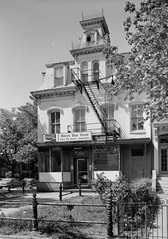Mary's Blue Room, Capitol Hill
Photo from the HIstoric American Building Survey.
I forget from time to time that the local preservation law in DC was sparked by the demolition of a building owned by church.
In 1966, the National Historic Preservation Act was passed, which included a system for designating historic districts through the National Register of Historic Places, a unit of the National Park Service. The NHPA also "protects" (or at least requires consideration of the historic aspects) buildings and sites from federal understakings.
A few years later, the Capitol Hill Historic District was created.
But Capitol Hill Baptist Churchwas still able to demolish this building, which was at the corner of 5th and East Capitol Streets NE.
Part of their justification was that they "couldn't afford to maintain the building." Plus they wanted more parking lots.

Just think, this prominent corner, now occupied by rowhouses constructed in the late 1990s (the "new" buildings were done so well that each is worth well over $1 million), was a parking lot for decades.
People realized that the federal preservation act only protected places with regard to undertakings by or funded by the federal government.--except for the fact that Congress is exempt from the Act due to separation of powers, which provides an extra dimension of threat faced by Capitol Hill that is somewhat unique.
So they worked to get local legislation passed to provide local protections against demolition in historic districts.
So the recent effort to provide an exception to churches in the city's historic preservation laws is sadly ironic.




1 Comments:
My dad, who was born in 1923 in the front room of his family house on Constitution Ave, NE, remembered the Victorian white clapboard building in its still swank middle age. By the time my brother, sisters, and I were old enough to walk to Fifth and East Capitol Street,NE it was past prime and needed paint and repair. The blue neon Mary's Blue Room sign added to its seedy good looks. (The Hill was declared historic in 1966 but buildings were torn down with little thought and, usually, no permission.)
When an unexpected demolition crew rolled up to Mary's one summer morning, neighbors rushed to the site, circling the fence to keep the machines out. Mary's Fifth Street neighbor, Libby Sangster, who, I'm guessing, was then 65 or 70 years old, ran across Fifth Street NE and into the Blue Room's yard and stood in front of the wrecking ball. Libby, the long-time owner of Antiques on the Hill, had a good eye for what must be saved.
The demo crew called their bosses and the police. The neighbors called the Washington Post, Evening Star, and the local news stations. Being the 60s on Capitol Hill, everyone over 5 knew how to organize a protest. When Congress had finally gave District residents the right to vote for president in 1961, everyone knew Home Rule was coming any day. It gave us confidence.
All the moms were stay-at-home. They'd gotten out the vote for Jack Kennedy and knew how to employ civil disobedience. They arrived with babies, toddlers, food, thermoses of coffee, and poster board. My mom brought what seemed like her most important possession-- markers. Newly invented and imported from Japan, they were stubby jars with screw-on lids, with a stiff felt wick coming through a small hole in the top, filled with smelly alcohol-based ink. (Red, blue, dark green and black). Posters were made on the spot. Older kids came from the playgrounds. Mothers and their children ringed the fence. When the dads got home from and joined the protest.
For two days (as I remember) lots happened and nothing happened. They were loud. Mindful of the younger protesters, they changed the Vietnam protest staple, Hell No, We Won't Go to the child-friendly No, No We Won't Go! The two and three-year-olds had a lot of practice saying no. They were delighted by adults shouting. The police came, delighting all the kids.
Reporters came and neighbors gave interviews. They took turns keeping the ring around the fence.They recruited more neighbors and made sandwiches.
The de-construction crew stayed on the clock and off the job. When it was too dark to knock down the once-grand house, they left.
The next day they came to work extra early, apparently figuring they couldn't be stopped once they started. Libby and some Hill families had gotten there earlier. An earth-moving machine slowly rolled forward. Libby sat down in front of it. The machines stopped.
Much of the second day was a standoff. Late in the day the Police, who had been standing in Fifth Street, chatting with protesters. Late in the day, it was decided that the church had the right to knock Mary's down.
Libby was threatened with arrest. She stayed seated until the police lifted her to her feet and steered her by her elbows toward a patrol car. The cameraman from Channel 4 filmed it all.
In the end, the Baptist Church, who owned the property, won.
The lot stayed empty for decades. In time, beautiful brick, historically correct houses were built on the space. This was a far better result than usual. Many of the teardowns in the city were replaced with oddly mod but charmless apartment buildings that did not stand the test of time.
The children protesting bragged for years that they had been on TV
Post a Comment
<< Home